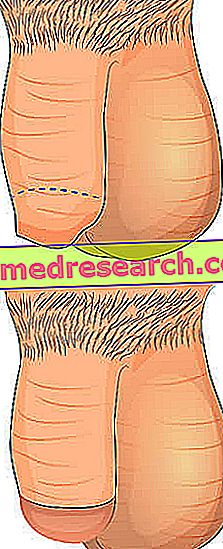Definition
A very ancient surgical practice, circumcision involves the total removal of the foreskin: consequently, the terminal part of the penis (glans) remains completely uncovered.

From ancient paintings, it can be seen that the circumcision procedure dates back to at least 6, 000 years ago, a widespread practice especially in Egypt: still, circumcision remains one of the most discussed methods in the medical field.
Circumcision in different cultures
The vast majority of male Muslims are circumcised, fomented by the desire to respect their religion: circumcision, for these peoples, represents a sort of initiatory ceremony to "belong to a culture", a permanent social mark, a form of endurance of pain to "survive" the difficulties of civilization and, finally, a ritual index of fertility.
However, 80% of men in the world are not circumcised.
For Muslims, circumcision is almost a moral as well as a religious obligation: Abraham was circumcised, Muhammad was his follower, circumcision is related to the pain that - based on their mentality - must always be tolerated by Islamic men, just like a "challenge to endurance, aimed at survival". Again, according to Islamic thought, the uncircumcised keep the impurities within their body, consequently the prayers addressed to their god are vain.
Neonatal circumcision is only rarely chosen as a function of genital diseases or anatomical malformations: more often than not, children are subjected to circumcision because they are driven by religious motives.
In Italy, circumcision is not carried out for religious purposes but, generally, when genital diseases (infections and inflammations involving the preputial foreskin and sulcus sulcus) are in progress: repeated infections at the genital level, could generate the progressive loss of 'elasticity of the skin of the penis, therefore difficulty in sliding the skin (sexual act, masturbation ...).
In the USA, it is estimated that the circumcision rate has clearly decreased (by about 90%) in recent decades, unlike, however, in the Korean countries, where circumcision was practiced especially during the period of the Second World War.
Globally, an estimated 13 million men are subjected to circumcision every year.
Why do we practice?
Circumcision is not carried out solely for religious purposes: the reasons that lead Westerners (above all) to undergo this practice are quite different. Among all, hygiene stands out: it seems, in fact, that circumcision is one that favors greater intimate hygiene; urine micro-leaks and smegma cannot stagnate between the foreskin and glans, because they are considered risk factors for balanitis, postites, balanoposthites and other genital inflammations.
Others, undergo circumcision because they are driven by the desire to improve the genital aesthetics or by the desire to perceive greater excitement during the sexual act.
Despite their will, many men are forced to undergo circumcision to resolve genital anatomical disorders (phimosis, paraphimosis) or to treat premature ejaculation. Other disorders that can be resolved or improved through circumcision include: lichen sclerosus of the penis, hypospadias (incomplete development of the urethra), urethral stricture, chronic penile lymphedema (rare). In some cases, even penile cancer could be treated, completely or partially, through circumcision.
Description of the Intervention
Before surgery, the patient must undergo a thorough specialist examination (urologist, andrologist and, when necessary, dermatologist). The patient, when he has acquired phimosis or genital infections, should contact his doctor as soon as possible and undergo the check, in order to heal (eventually) as soon as possible.

Surgical practice is carried out in a day-hospital: the patient is anesthetized in situ by inoculation of xilocaine (or lidocaine) 1% directly into the nerves of the penis.
In the child, general anesthesia is preferable.
After anesthetizing the part of the patient, we proceed with the surgical removal of the flap of skin that covers the glans, using a laser or scalpel: the operation lasts, approximately, 40 minutes.
We recommend the suspension from sporting activity for 7 days and sexual activity for about four weeks to allow wounds to heal permanently.
The stitches fall spontaneously, usually after a couple of weeks; the reduction of sensitivity at the glans level, with relative thickening of the aforementioned area, usually occurs after four weeks.
The patient remains satisfied with the intervention in 80% of cases.
Circumcision against premature ejaculation
Many men undergo circumcision associated with the glandular neurotomy to obviate that disorder (definitely embarrassing for many men) of premature ejaculation. It seems that the hypersensitivity of the glans represents the most famous cause of premature ejaculation: in these subjects, even a slight sexual excitement is sufficient to promote orgasm, since the nerve fibers responsible for conducting excitatory, hyper-excited signals, cause the muscle contraction, consequently the smooth musculature that covers the seminal tract stimulates the "early" release of the sperm [from www.circoncisione.net]. To avoid this inconvenience, the man, after an andrological visit, can decide to undergo this operation, which consists of two phases:
- Real circumcision: surgical removal of the foreskin that covers the glans
- Glandular neurotomy: some nerve fibers located at precise points, near the glans groove are sectioned. In this way, the sensitivity at the gland level is clearly diminished
Circumcision and venereal diseases
Particularly interesting are the new discoveries in the medical-scientific field: it seems that circumcision is also a valid aid to reduce the risk of infection from sexually transmitted diseases. It is not accurate to say that circumcision completely protects from STIs, but it is believed that the chances of contracting HIV (for example) are reduced by at least 60% following the removal of the foreskin that surrounds the glans. In the USA, for example, many men undergo circumcision for prophylactic purposes against venereal diseases.
Let's look at the reasons.
First of all, the foreskin seems to be the ideal habitat of the HIV virus: the anatomical zone of the foreskin has all the ideal characteristics for the nesting of the virus, consequently through the removal of the part, the virus does not find the ideal conditions to settle .
Statistical data confirm the theory:
- 30% drop in HIV / AIDS infections in women with circumcised partners (study done in Uganda, examining a sample of 12, 000 people)
- Women with circumcised partners are less likely to contract bacterial vaginitis and Trichomonas vaginalis
- Decline in AIDS patients in the African regions where circumcision is a widespread practice
It should be pointed out that male circumcision is not used as a prophylaxis against chlamydia, syphilis and gonorrhea. Concerning the possibility of decreasing the risk of HPV (papilloma virus) following circumcision, there are conflicting theses: some believe that circumcision is not a prophylactic practice against HPV, other exponents of Research, however, are more hopeful on this front. It is not yet possible, therefore, to state with certainty that HPV can be prevented through male circumcision: some years will have to wait for confirmation or not of these hypotheses.
However, condoms remain the safest way to protect against venereal diseases.
Circumcision: complications and reflections »



